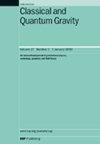引力波探测中被动热控材料的温度噪声抑制特性研究
IF 3.6
3区 物理与天体物理
Q2 ASTRONOMY & ASTROPHYSICS
引用次数: 0
摘要
天基引力波(GW)探测器要求在毫赫兹频段具有很高的探测灵敏度。目标频段(0.1 mHz-100 mHz)内以温度振幅谱密度(TASD)为特征的温度噪声必须限制在 μK Hz-1/2 水平。然而,超低频的 TASD 会急剧上升,导致无源热控材料 (PTM) 的温度噪声抑制失效。本文提出了 "频率势垒 "来表示超低频处的 TASD 急剧过渡,并建立了温度噪声传输模型来研究热流频谱特性和 PTM 热物理性质对 TASD 和频率势垒的影响。结果表明,在一定的热流频率下,降低 PTM 的热导率可明显降低 TASD,但存在最低 TASD 限制,且随着热流频率的降低而增加。随着 PTM 热导率的降低和比热容的增加,频率势垒也随之降低。高比热容材料能积聚更多的热量,而低导热系数材料则能衰减更多的温度波动,从而能在低热流频率下有效抑制温度噪声,扩大 PTM 的温度噪声抑制范围。所获得的频率阻隔相关性为在星载 GW 探测中选择温度噪声抑制材料的标准提供了指导。本文章由计算机程序翻译,如有差异,请以英文原文为准。
Study on temperature noise suppression characteristics of passive thermal control materials in gravitational wave detection
Space-borne gravitational wave (GW) detector requires high detection sensitivity in millihertz band. Temperature noise characterized by temperature amplitude spectral density (TASD) in target frequency band (0.1 mHz–100 mHz) must be limited to μK Hz−1/2 level. However, TASD at ultra-low frequency ascends sharply, leading to temperature noise suppression failure of passive thermal control material (PTM). In this paper, we proposed ‘frequency barrier’ to denote the sharply TASD transition at ultra-low frequency and developed temperature noise transmission model to study the effect of heat flow spectral characteristics and PTM thermophysical properties on TASD and frequency barrier. The results showed that reducing PTM thermal conductivity could decrease TASD apparently at certain heat flow frequency, but minimum TASD limit exist which increases with decreasing heat flow frequency. Frequency barrier decreases with decreasing thermal conductivity and increasing specific heat capacity of PTM. High heat capacity materials accumulate more heat, while low thermal conductivity materials attenuate more temperature fluctuations, enabling effective temperature noise suppression at low heat flow frequency and broadening PTM’s temperature noise suppression range. The obtained frequency barrier correlation provides guidance for the material selection criterion of temperature noise suppression in space-borne GW detection.
求助全文
通过发布文献求助,成功后即可免费获取论文全文。
去求助
来源期刊

Classical and Quantum Gravity
物理-天文与天体物理
CiteScore
7.00
自引率
8.60%
发文量
301
审稿时长
2-4 weeks
期刊介绍:
Classical and Quantum Gravity is an established journal for physicists, mathematicians and cosmologists in the fields of gravitation and the theory of spacetime. The journal is now the acknowledged world leader in classical relativity and all areas of quantum gravity.
 求助内容:
求助内容: 应助结果提醒方式:
应助结果提醒方式:


